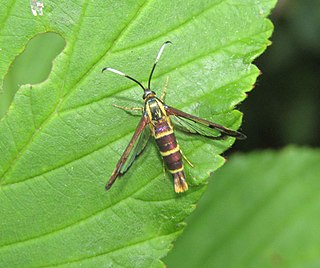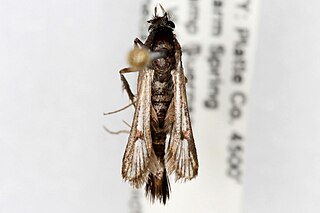
In ancient Roman religion and myth, Carmenta was a goddess of childbirth and prophecy, associated with technological innovation as well as the protection of mothers and children, and a patron of midwives. She was also said to have invented the Latin alphabet.
Carmenta is a genus of moths in the family Sesiidae.
Carmenta albociliata is a moth of the family Sesiidae. It was described by Engelhardt in 1925. It is known from North America, including Texas and Arizona.
Carmenta anthracipennis, the liatris borer moth, is a moth of the family Sesiidae. It was described by Jean Baptiste Boisduval in 1875, and is known from the United States, including Florida, Texas, Massachusetts and Illinois.
Carmenta arizonae is a moth of the family Sesiidae. It was described by William Beutenmüller in 1898. It is known from the US state of Arizona.
Carmenta armasata is a moth of the family Sesiidae. It was described by Herbert Druce in 1892. It is known from the US state of Texas.
Carmenta auritincta, the Arizona clearwing moth, is a moth of the family Sesiidae. It was described by Engelhardt in 1925. It is known from south-eastern Arizona and northern Mexico.

Carmenta bassiformis, the eupatorium borer moth, is a moth of the family Sesiidae. It was described by Francis Walker in 1856, and is found in the United States from Massachusetts to Florida, west to Wisconsin, Kansas and Texas.
Carmenta corni, the aster borer moth, is a moth of the family Sesiidae. It was described by Henry Edwards in 1881. It is known from North America, including Wisconsin.
Carmenta giliae is a moth of the family Sesiidae. It was described by Henry Edwards in 1881, and is found from western Alberta to north-western British Columbia, south to Arizona and New Mexico. The habitat consists of mid-to-high elevation montane meadows.
Carmenta odda is a moth of the family Sesiidae. It was described by W. Donald Duckworth and Thomas Drake Eichlin in 1977. It is found in the United States from South Carolina to Florida.
Carmenta ogalala is a moth of the family Sesiidae. It was described by Engelhardt in 1946. It is known from Colorado.
Carmenta pallene is a moth of the family Sesiidae. It was described by Herbert Druce in 1889. It was described from Tabasco in Mexico, but it is also known from Arizona in the United States.
Carmenta pyralidiformis, the boneset borer, is a moth of the family Sesiidae. It was described by Francis Walker in 1856. It is known from the United States, including Arkansas, Illinois, Maryland, Massachusetts, Michigan, Missouri, New Jersey, Ohio and Virginia.
Carmenta texana, the Texana clearwing moth, is a moth of the family Sesiidae. It was described by Henry Edwards in 1881 and is known from the US states of Texas and Florida.

Carmenta verecunda is a moth of the family Sesiidae. It was described by Henry Edwards in 1881, and is known from the United States, including Colorado, Utah, California and Arizona.
Carmenta wellerae is a moth of the family Sesiidae. It was described by W. Donald Duckworth and Thomas Drake Eichlin in 1976. It is known from southern Arizona in the US and northern Mexico. The habitat consists of mountains and foothills.
Carmenta theobromae, the cocoa fruit borer, is a moth of the family Sesiidae. It was described by August Busck in 1910, and is known from Colombia and Venezuela.
Carmenta laurelae is a moth of the family Sesiidae. It was described by Larry N. Brown, Thomas D. Eichlin and J. Wendell Snow in 1985, and is known from the US state of Florida.


